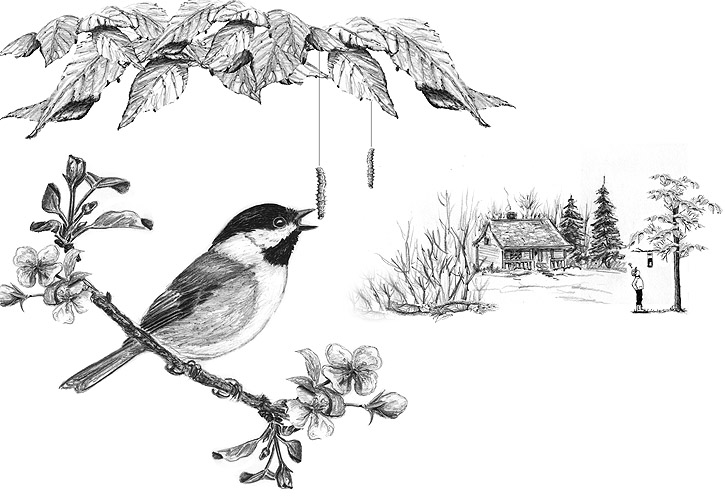
FYI:
The following is an update of a column I wrote years ago. It’s a question that never seems to go away, no matter how many times I answer it. I feel like the veterinarian who has to repeatedly explain that a dog’s dry nose is not a sign of illness…only vets get paid more for their answers.
Dear Bird Folks,
For the past few months I have been getting tons of birds at my feeders. Suddenly, however, they have stopped coming. I haven’t changed anything. I’m still using the same feeders and the same special seed mixture, which I buy locally. What is going on? Has anything happened to the birds?
– Kristen, Reading, MA
You’re lucky, Kris,
Fortunately for you, I’m too busy watching all of the current political silliness to give you a hard time for using “special seed mixture.” You know how I hate that stuff. To make things worse, you buy your mixed seed from some other store. If you are going to buy crappy seed, you could at least buy it from me. My mixed seed is just as lousy as the next guy’s. And while I’d love to blame your lack of birds on your birdseed, this is simply not the case. It’s not your seeds’ fault. Blame the calendar; June is not a feeder-friendly month.
There are two months each year when the “no-bird syndrome” strikes the feeder world. The first is December, when many of our birds have migrated away and lots of natural food is still readily available. In addition, December is the month when many of the old schoolers traditionally begin to feed birds for the season. (For some reason, they think birds only eat in certain seasons.) Combine fewer birds, lots of natural food and more feeder choices, and we have fewer birds at our feeders. In December I get tons of calls from folks wondering where the birds are, yet not a single one ever wishes me a merry Christmas. It’s all so sad.
The second “no-bird” month is June. Now everyone is thinking, “June? How can that be? All the birds are back and all the old schoolers have put their feeders away for the season. Why is June bad?” You see, June is noted for three things: lots of weddings, lots of graduations, and lots and lots and lots of bugs. Now matter what kind of super-food we put in our feeders, we can’t compete with juicy, squishy bugs.
As I write this, there is a birdhouse filled with baby chickadees just outside of my window. About fifty feet from this crowded birdhouse is a birdfeeder filled with food. (I’m talking about good food, not a questionable “special mix” bought from some generic store in Reading.) So far I have not seen a single cardinal, titmouse, nuthatch or Blue Jay at this feeder. I’ve also not seen a single chickadee. You would think that the chickadee parents, with a nest filled with hungry baby birds, would be visiting a feeder constantly. Nope. Baby birds grow much faster when fed a diet of protein-packed insects. Seed simply doesn’t have the growing power that insects do. And like most parents, birds want their kids to grow up and get out of the house as fast as possible. Thus, bugs, not seeds, is their food of choice.
Right now the most common birds at my feeders are goldfinches. Why finches? Finches are vegetarians. They would rather have their kids grow more slowly than allow themselves to partake in the nasty habit of eating meat. I also have a few sparrows, which are mostly vegetarians. And, of course I have grackles. Grackles are vegetarians, fruitarians, bugtarians, wormtarians, breadtarians, liverwurstarians, etc. June or no June, grackles never pass on free food. That’s just how they roll.
I know the lack of feeder birds is disappointing, Kris, but no one feels your pain more than I do. June is Death Valley to the bird food industry. Even in the middle of winter, when the Cape is quiet and most of my customers are sitting in their lanais in Florida, we sell more seed than we sell in June. There’s good news, however. Once the baby birds have fledged and are flying around, they’ll come to your feeders and they’ll be looking for birdseed. In fact, you’ll be getting so many birds, you’ll think the special mixture you are using is actually good. (It’s not.)
On a similar subject: Much of the above info also applies to the returning Baltimore Orioles. When the hungry orioles first arrive in early May, they eat whatever we put out for them. The most popular food items are sugar water (offered in hummingbird-style feeders), fresh orange halves and grape jelly. But everything has changed since early May. Right now the trees are covered with little green wormy-caterpillars. The caterpillars may be winter moth larvae, but I don’t really know. I’m neither an entomologist nor a bugtarian. The abundance of insects has caused the orioles to ignore our offerings. Instead, they are chowing on the wormy-caterpillars. If you aren’t getting any orioles, try putting out short pieces of string or yarn. Even bug-stuffed orioles need material to build their nests, and they find yarn irresistible. If you don’t have any yarn, just ask the nearest grandmother. If there’s a grandmother around, a knitting bag won’t be far away. Like your other feeder birds, once the oriole babies fledge, you are likely to see them return to your feeders, so don’t give up. I’d write more about orioles, but I have to call my vet. I still don’t know the answer to that dry nose thing.